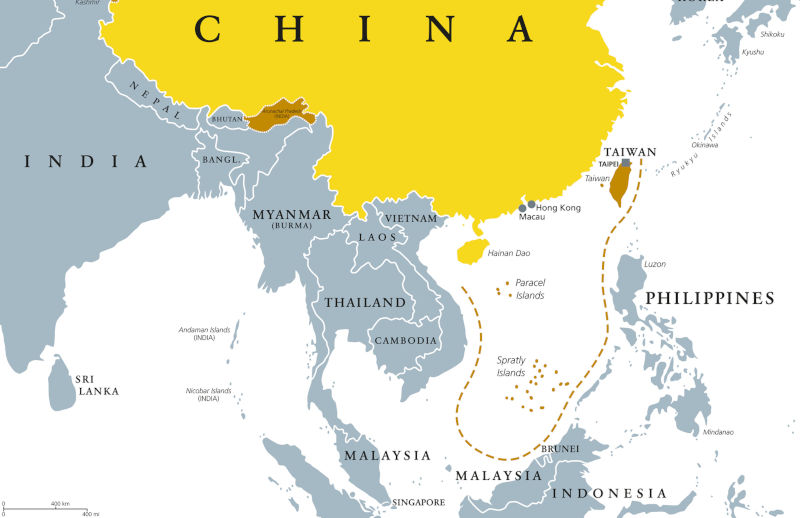A worst case scenario for the South China Sea
May 11, 2023
The increasing militarisation of the South China Sea disputes sets the stage for the worst case scenariofrequent and widespread conflict that eventually results in a military confrontation between China and the US.To avoid this scenario, the reality is that China, its rival claimants and the U.S. have to compromise.
Chinas position, policy and practices in the South China Sea have become counterproductive to its attempts to enhance its soft power and relations with Southeast Asia. Nevertheless it continues them and has even doubled down on its historic claimthat was rejected by an international arbitration panel– to much of the Sea by enforcing it with its maritime militia, coast guard and occasionally even its navy. Chinas rival claimantsIndonesia, Malaysia, the Philippines and Vietnam– are pushing back with their own enhanced military presence, upgrades and collaboration with the U.S. and other outside powers. This increasing militarisation of the South China Sea disputes sets the stage for the worst scenariofrequent and widespread conflict that eventually results in a military confrontation between China and the U.S.
China has been trying to build up its soft power in the region. It has stepped up its economic and diplomatic efforts via its Belt and Road Initiative to persuade its rival South China Sea claimants to compromise and recognise its interests and concerns. It is proposing an inclusive Indo-Pacific as an alternative to the U.S.s Free and Open Indo-Pacific vision that excludes China. Its new Foreign Minister Qin Gang has diplomatic efforts to broaden and deepen engagement with Southeast Asian nations including its rival claimants and pledged to keep the South China Sea peaceful and stable. Now it has also proposed an over arching grand Global Security Initiative (GSI) that includes a promise to conduct bilateral and multilateral security operation with all countries and regional organisations. As a counter to what it sees as US led cabals against it, China may even try to build its own economic and security grouping in the region beginning with China leaning Laos, Cambodia and Myanmar. It could try to persuade Thailand to join it and Vietnam to at least remain neutral.
But if these soft power efforts do not persuade its rivals to compromise on their claims, it may well decide to do whatever it takes to achieve its interests in the South China Sea. This would be a realisation of the ancient Thucydian proverb that ’the strong do what they can and the weak suffer what they must’. Indeed, it could well mean a heavy handed use of its military stick and its economic might to reward and punish uncooperative rival claimants.
In this scenario, China would generate widespread opprobrium and rival claimants would likely move even closer to the U.S. But China may calculate that it can weather the ensuing political storm. It knows that it holds long term advantages over the U.S. as well as its rival claimants. It is a permanent fixture in the regionit will always be thereand its economic and military might are rapidly and inexorably expanding.
Indeed, it may assume that there is really very little the rival claimants can do but whine, wail, and plead with the U.S. to back them up militarily. China may calculate that that is unlikely because, notwithstanding US rhetoric, no core US security interests are directly threatened and that the US public and Congress will not support another potentially disastrous foreign adventure in defence of vague concepts like the international order. Moreover, if China feels sufficiently threatened it may counter US initiatives to surround and contain it by implementing the U.S.s worst nightmare –drawing closer to Russia militarily
Yes this is a worst scenario. But it is a realistic alternative response to the disputes that China may find increasingly attractive as its rival claimants positions harden and the U.S. becomes ever more deeply involved. The U.S. and Chinas rival claimants should at least consider the possibility that the chickens of their anti-China policies and actions will come home to roost.
Of course Chinas rival claimantsand the U.S.want to avoid this worst scenario. But to do so they will have to compromise and address some of Chinas concerns and interests. Perhaps the best that can be accomplished is to negotiate a series of deals.
For the U.S., this would include agreement to back off on its enhanced diplomatic embrace and military support for Taiwan. For Chinas rival claimants in the South China Sea, it means reaching a modus vivendi with China. Perhaps the best they can hope for is arrangements in which China maintains its historic claim to placate its nationalists but does not enforce it. This could include Chinas priority access under rival claimants management–to a share of what they consider their fish and petroleum resources. This might be in exchange for Chinas restraint from intimidating its rivals and providing its forefront technological and capital assistance in harvesting next generation methane hydrate resources on their continental slopes.
This scenario is not about right and wrong. Rather, it is about relative power. The reality is that China, its rival claimants and the U.S. have to compromise. No compromise means an end point of Chinas absolute hegemony over the South China Sea or a universally catastrophic conflict. Political and military analysts should realise this and advise accordingly. However if they have realistic alternatives short of risking war that do not include the forlorn hope that China will back off its claims, I and the region are all ears.
An edited version of this piece appeared in the South China Morning Post May 6, 2023
